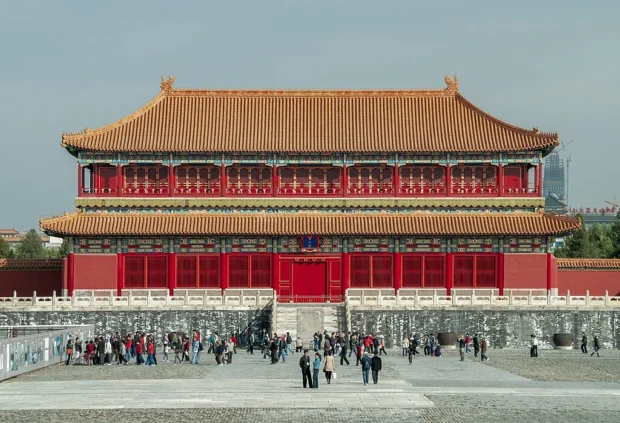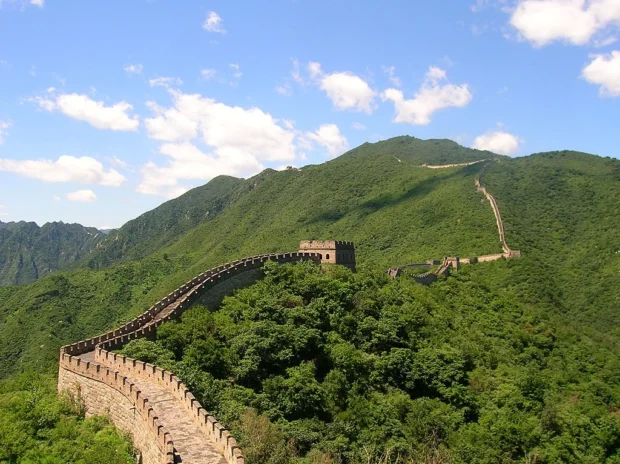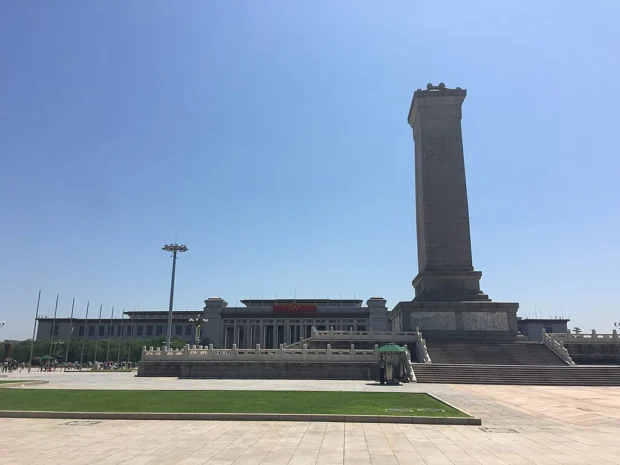Beijing, the capital city of China, is a place full of history, culture, and amazing sights. Walking through its wide streets, I felt the city’s deep stories in every step. Famous landmarks stand tall, mixing old and new in a way that makes the city unique. In this article, I will share my personal experiences of Beijing’s beautiful places, tasty food, easy travel tips, and simple ways to enjoy the culture. Whether you come for a few days or a week, Beijing has something special waiting for you.
Table of Contents

Iconic Places to Visit in Beijing
One of Beijing’s best-known landmarks is the Great Wall. It stretches for thousands of kilometers and was built hundreds of years ago to protect China from invaders. I stood on a part called Mutianyu, where the wall snakes over green hills like a giant stone dragon. The view from there is incredible-especially in the late afternoon light. It is a great spot for photos that show the wall’s strong lines against the sky.

Closer to the city center is the Forbidden City. This huge palace complex was home to Chinese emperors for centuries. Walking along its long, red walls and golden roofs, I noticed how every building fits into the whole design perfectly. The courtyards and gates create a rhythm that feels calm yet full of power. From above, the symmetrical layout looks like a beautiful chessboard. Be ready to spend several hours here to enjoy its many rooms and details.

Not far is Tiananmen Square, one of the largest public squares in the world. It is famous for its vast open space and important political history. Here, you can see the Monument to the People’s Heroes and the magnificent Great Hall of the People. I visited early in the morning, when soft light bathed the buildings and the square was peaceful, making it easier to appreciate its scale and neat geometry.

Taste Beijing’s Special Dishes and Food Spots
Food in Beijing is a journey itself. One dish you must try is Peking duck, known for its crispy skin and tender meat. The taste was rich and smoky, and eating it with thin pancakes, sweet sauce, and fresh vegetables felt like a special ceremony. I found great duck in the Qianmen area, where small shops line old alleys.

Another favorite is jianbing, a kind of savory pancake sold by street vendors. It is fast, cheap, and delicious. Watching the chef spread the batter, crack an egg, add sauces and herbs on a hot round pan is a small performance. This snack is perfect for breakfast or a quick lunch while exploring the city.

For a deeper look at Beijing’s food, I also visited the Donghuamen Night Market. Here, you can find exotic snacks like scorpions on sticks and fried insects. It’s a lively place with bright lights and voices blending into a unique atmosphere. Even if you do not try everything, watching the food preparation is a cultural experience.

Getting Around Beijing with Ease
Beijing’s transport system is modern and convenient. From the airport, you can take the Airport Express train straight to the city center in about 20 minutes. It is fast and avoids the traffic jams that sometimes happen on the roads.

Once in the city, the subway is the best way to move around. It covers many famous spots and is easy to use, even if you don’t speak Chinese. Signs have English, and stations are clean and safe. Buses are also available, but they can be crowded and slower.

For short trips, walking is perfect for seeing the city’s beauty up close. Beijing’s wide sidewalks and parks make it enjoyable. Also, you can rent an electric bike or scooter to get around quickly, especially in central areas.

Understanding Beijing’s Culture and Manners
Meeting locals in Beijing, I learned some polite habits. Greeting with a slight bow or nod shows respect, especially to older people. When you eat with others, it is polite to wait for the eldest person to start before you begin. Also, leaving a little food on your plate means you are satisfied and full.

One important custom is to avoid pointing with your fingers or touching someone’s head-it is considered rude. Instead, use your whole hand to gesture. When giving or receiving items, use both hands as a sign of politeness.

The phrase “ni hao” (nee how) means “hello” and is a good way to start conversations with strangers. “Xie xie” (shay shay) means “thank you” and will be appreciated often. If you want to ask “how much?” at markets, say “duo shao qian?” (dwo shao chyen?). Trying these words brings smiles and shows respect for the culture.

Quiet Corners and Special Views in Beijing
Not everything in Beijing is busy and crowded. I found quiet peace in the Temple of Heaven park early one morning. The round temples have soft blue rooftops and stand in perfect circles. Watching older people practice tai chi in the mist gave me a sense of calm that contrasts with the city’s noise.

Another hidden gem is the 798 Art District, a former factory area turned creative space. The buildings have sharp industrial lines and colorful murals. Walking there, I felt the rhythm of urban art mixing with history, a blend of old and new that speaks to the city’s energy.

For panoramic city views, I climbed a tower near the CCTV building. From here, I saw Beijing’s wide streets and traditional roofs stretching into the distance. The sun set behind modern skyscrapers, making a golden wash across the city. This moment captured the unique harmony of Beijing-ancient roots and modern growth side by side.
For a serene contrast to Beijing’s busy streets, the Summer Palace offers tranquil gardens and imperial history worth exploring.
Where to Stay for a Comfortable Visit
Choosing where to stay depends on what you want to see. Staying near the Dongcheng or Xicheng districts puts you close to many landmarks and good food. These areas offer quiet hotels and guesthouses with friendly service and easy access to public transport.
For more modern vibes, Chaoyang district has business centers and shopping. Here, the streets are busy, and many cafes and restaurants offer international menus. It is a good option if you want city life with all conveniences nearby.
After exploring Beijing’s rich heritage, you might like to explore Ho Chi Minh City, where vibrant street markets and riverside spots create a different urban charm in Southeast Asia. Ho Chi Minh City Travel Tips
For a calm place filled with tradition, the Temple of Heaven offers unique charm among Beijing’s busy sights.
Whatever your choice, try to pick a place near a subway station. This will save time and let you visit different parts of the city easily. Beijing is large, but the transport network makes it simple to move around quickly.
Final Thoughts on Beijing’s Unique Appeal
Walking through Beijing feels like stepping between different times. Ancient walls and modern towers create an architectural dance visible in every street. The city’s wide spaces and careful design show the importance of balance and harmony in Chinese culture.
Photographing Beijing, I noticed how sunlight plays on buildings and parks, drawing attention to details many visitors miss. The city’s rhythm changes with the hours-from the quiet morning parks to the busy night markets. Each moment offers a new way to connect with Beijing’s heart.
If you are interested in history, art, or just want to see a city that mixes the past and future beautifully, Beijing is a place worth visiting. Its landmarks tell stories, its food delights the senses, and its people offer warmth and friendliness that make every visitor feel welcome.

- Beijing China Hall-of-Prayer-for-Good-Harvests-01 by CEphoto, Uwe Aranas on Wikimedia Commons – cc by-sa 3.0
- Beijing forbidden city Belvedere of Embodying Benevolence-20071018-RM-142403 by Ermell on Wikimedia Commons – cc by-sa 4.0
- Great Wall of China July 2006 by Velatrix on Wikimedia Commons – cc0
- Pékin Le temple du Ciel by Pierre André Leclercq on Wikimedia Commons – cc by-sa 4.0
- Tiananmen IMG 4280 Tiananmen Beijing – National Museum of China by Bjoertvedt on Wikimedia Commons – cc by-sa 4.0
- Summer Palace – Marble Boat by xiquinhosilva on Wikimedia Commons – cc by 2.0
- Beihai Park 65482 by xiquinhosilva on Wikimedia Commons – cc by 2.0
- ONE OF THE THIRTEEN MING TOMBS BEIJING CHINA OCT 2013 (8812725032) by calflier001 on Wikimedia Commons – cc by-sa 2.0
- Beijing Hutong – panoramio (5) by The Erica Chang on Wikimedia Commons – cc by 3.0
- Beijing (November 2016) – 064 by Another Believer on Wikimedia Commons – cc by-sa 4.0
- ·˙·ChinaUli2010·.· Beijing – 798 Art-District – panoramio (3) by ·˙·ChinaUli2010·.· on Wikimedia Commons – cc by 3.0
- 2016-09-04 Beijing Nanluoguxiang anagoria 11 by Anagoria on Wikimedia Commons – cc by 3.0
- Beijing YONGHEGONG Lama Temple – panoramio (11) by The Erica Chang on Wikimedia Commons – cc by 3.0
- Beijing Olympic Green by Picrazy2 on Wikimedia Commons – cc by-sa 4.0
- Guanmiao Pavilion (Jingshan Park) by EditQ on Wikimedia Commons – cc by-sa 4.0
